
Honda Jazz 2018 review
Honda gave its Jazz range a little tweak in late 2017 to hand us the MY18 Honda Jazz. Some features were lost, and a few gained in an effort to keep up with the very fine Mazda2.
Browse over 9,000 car reviews

You know that feeling when your telco introduces some cool new feature - like free Netflix or cheap international roaming – only for you to discover you didn't spend enough on your plan to qualify for them?
That’s like the Kia Rio S. While the new and improved Rio formula for 2019 includes two new transmissions and one new engine, the base-model S misses out on any of those needed improvements.
Sure, it still has those killer Rio looks, but is the rest of the package enough to justify its $17,490 cost of entry in 2019?
I spent the week before Christmas in a Santa suit-red one to find out.
| Kia Rio 2019: S | |
|---|---|
| Safety rating | |
| Engine Type | 1.4L |
| Fuel Type | Regular Unleaded Petrol |
| Fuel Efficiency | 6.2L/100km |
| Seating | 5 seats |
| Price from | $12,320 |
As I mentioned, the cost of entry for the automatic Rio S is $17,490. With the $520 ‘Signal Red’ paint, the as-tested for this car comes to $18,010.
In the base-model stakes, every dollar is going to count, so consider you can have Honda’s entry-level Jazz VTi with an automatic for $16,990, the Mazda2 Neo auto at $16,990 and the Suzuki Swift GL Navigator auto at $17,990.
So, the Rio S is more expensive than two of those very appealing options, but multimedia inclusions are one of the Rio’s strong points. You get easily one of the best looking and functioning 7.0-inch multimedia touchscreens at this end of the market. It has a sensible design, a responsive touch interface, big-chunky shortcut buttons, supports Apple CarPlay and Android Auto, and Bluetooth connectivity.

There’s also an excellent reversing camera and rear parking sensors, but that’s about where the good equipment comes to an end. You do get the expected inclusions at this price; halogen headlamps, hard-wearing cloth interior trim, dorky-looking 15-inch steel wheels and auto headlamps.
Missing is cruise control - available on all three of those competitors - alloy wheels and sat nav (both standard on the Swift) and, most importantly, AEB which is standard on the Mazda2. More on that in the ‘safety’ section, though.

In terms of value, the Rio S would be in strong contention if it were $1000 cheaper, but could use the addition of AEB, alloy wheels, or at least cruise control to justify its current price-point.

Here is where you certainly won’t be disappointed. The Rio looks and feels fantastic for an entry-level car.
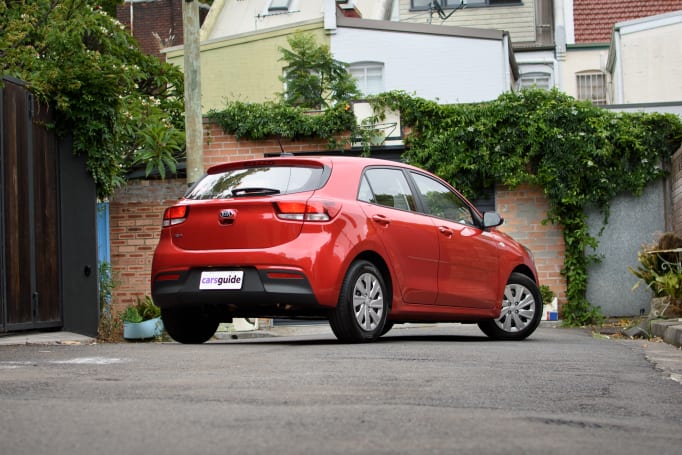
The European design influence of Kia’s ex-Audi design boss, Peter Schreyer, is clear through the car’s signature grille, neatly squared-off dimensions and its wonderfully resolved rear.
It’s more conservative than the design of the Mazda2, but much more modern than that of its distant-cousin, the Hyundai Accent, or competitors like the Jazz or Yaris.
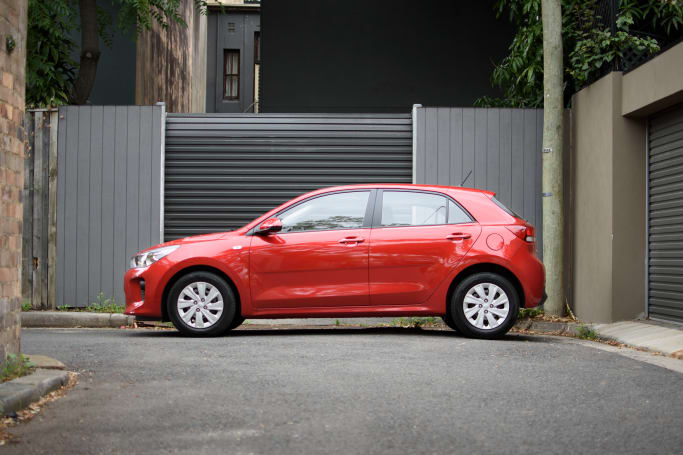
The Signal Red on our car really makes the most of those black plastic highlights in the grille, window linings and wing mirrors, although it perhaps brought a little too much attention to those 15-inch steel wheels and their average-looking plastic hubcaps.
Inside is also fantastic. The seat design is up to date, with nice synthetics and a modern-looking pattern, and the three-spoke wheel is slick, but finished in a nasty plastic. The real highlight is the almost premium-looking dash design.
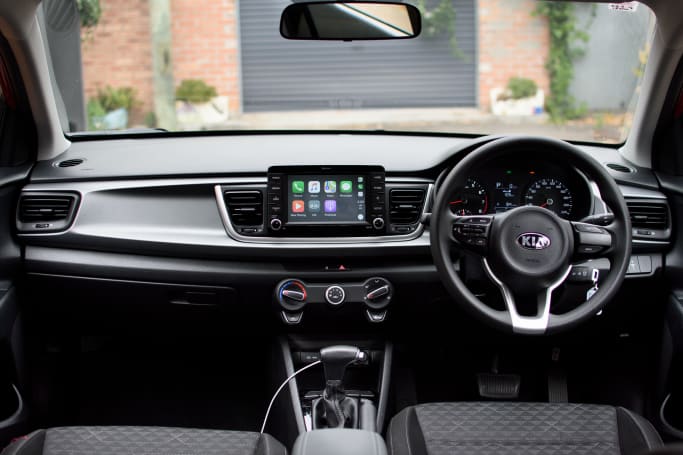
The matte-grey insert running the length of the dash is an elegant solution compared to most competitor’s single-colour plastic-clad interiors, and the tasteful chrome and black contrasts around the vents and instruments adds to the European flavour.
The lack of legroom under the steering wheel was a bit of a let-down in an otherwise great-looking and spacious cockpit.
The sturdy, squared-off design gives the Rio’s interior heaps of room for occupants. Apart from the limited legroom for the driver, the car feels almost a size up in terms of arm-flailing space and headroom.
There’s a slew of sneaky spots for stowing items, including big trenches and massive bottle holders in the doors, a decently sized glovebox, and – rare for a car in this segment – a centre-console box (you can add one to a Mazda2, but it’ll cost you almost $500).
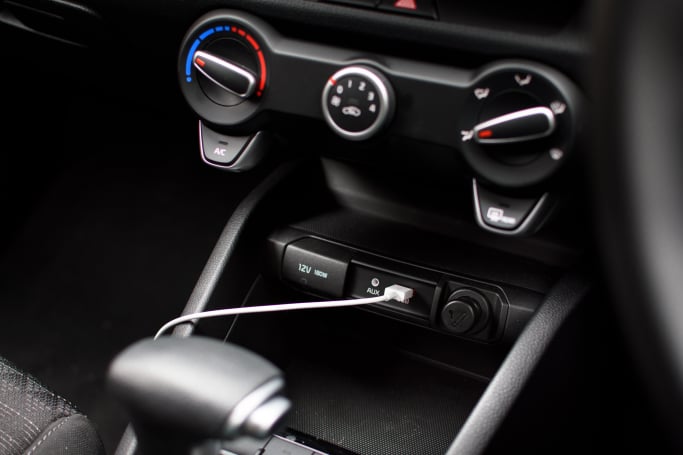
Our car had fitted an ashtray in one of the centre cupholders if you’re into that, and there’s a massive two-tiered trench under the air-conditioning controls which house two 12-volt charge points, an auxiliary input and the primary USB port.
Rear passengers are even treated to decent legroom and decent cupholders in the doors, but there are no vents and just a single power outlet in terms of amenities.
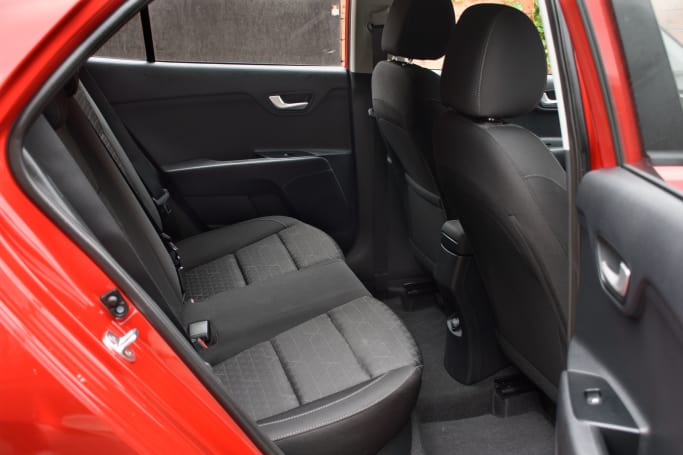
The boot provides 325 litres (VDA) of capacity, which ranks well in this class. It’s far superior to the Mazda2’s 250L, although it can’t beat the Honda Jazz, with it’s "magic seats" and 354L boot. The Suzuki Baleno (355L) and Hyundai Accent (370L) are also out in front.
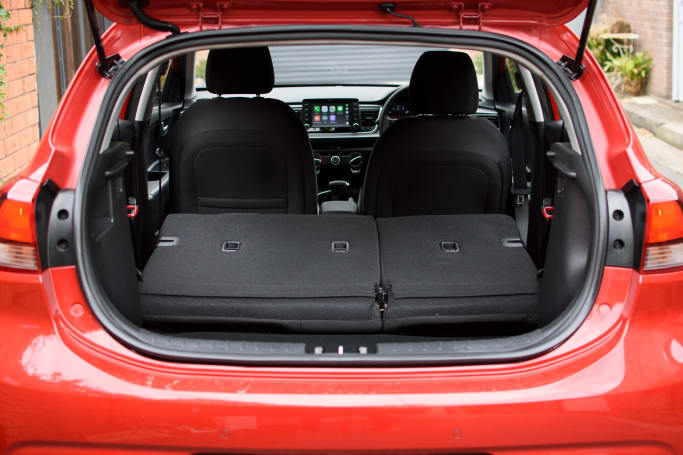
Space maxes out at a decent 980L with the seats folded flat, and in my test of the manual S last year I was able to fit a 190cm long plank of wood in there.
One small practicality niggle I had was the low front bumper would occasionally catch on ramps. A little more clearance would have been welcome.
The Rio S misses out big time under the hood. It’s stuck with an old-fashioned 1.4-litre four-cylinder engine producing 74kW/133Nm. While those power figures aren’t tragic compared to competitors, it’s the combination with an old-feeling four-speed automatic that makes the whole set-up seem hopelessly outdated in 2019.

There are simply not enough ratios to make for a smooth drive or a reasonable fuel figure. Driving the Rio was probably the first time I found myself wishing the Korean brand had simply implemented a Continuously Variable Transmission instead.
If you’re set on the Rio, consider spending the extra $1500 for the new Rio Sport which has a six-speed transmission.
The four-speed transmission had its effect on my fuel usage for the week. While Kia claims you’ll extract 6.2L/100km from the Rio, my week of driving produced a significantly worse 9.5L/100km.

I was able to get that down to 8.0L/100km in the six-speed manual version of the S, showing the value extra ratios (and the ability to have more control over the gears) offers.
Mercifully, the Rio S drinks base-grade 91RON unleaded petrol.
Driving the Rio S proved frustrating. The excellent suspension tune and ride quality were writing cheques that the lackluster drivetrain simply couldn’t cash.
Even here in the base-model, the ride (which is tuned here in Australia) is excellent. The little hatch rides flat through the corners, and the steering is direct and full of feel. Over larger bumps it performs admirably, soaking up most disturbances without much shudder making its way into the cabin.
What does make its way into the cabin, however, is quite a lot of noise. While not unusual in the small car segment, the Rio’s road noise is harsh on most surfaces, and tyre noise really builds at freeway speeds. Freeway driving wasn’t particularly pleasant in other ways, too, considering the S misses out on cruise control.
While the engine and transmission were largely fine on flat, straight roads, anything even remotely challenging - such as driving up a hill or attempting an overtaking manoeuvre - revealed some less-than-impressive characteristics.
It simply takes too long in the top two cruising gears for the engine to reach its 4000rpm peak torque point, and pushing the pedal to the firewall out of sheer frustration causes it to surge to the redline in first or second gear.
It makes for a noisy, jerky drive which could easily have been smoothed out by a smaller turbocharged engine with a lower peak torque point, or even just a few more gears.
It’s a let down, given you are charged some $500 for the automatic version of the S, and there are much better engines and transmissions available further up the range.
Basic Warranty
7 years / unlimited km warranty
ANCAP Safety Rating

The Rio maintains a maximum five-star ANCAP safety rating from 2017, although misses out on any kind of active safety refinements.
To be fair, most cars don’t get the luxury of autonomous emergency braking (AEB) at this price, but the Mazda2 Neo proves that it can (and should) be done.
To get AEB on the Rio you need to spend an extra $4500 to get into the top-spec GT-Line (which is, by far, the best Rio anyway, read my review of it here).
What you do get is six airbags as well as the standard suite of stability and traction controls. ANCAP gave the Rio full marks for side and pole impact scores.
The Rio comes with Kia’s ever impressive seven-year, unlimited-kilometre warranty program, and it’s easily one of the car’s strongest points against its competitors.
Suzuki and Toyota, for example, continue with a three-year, 100,000km plans, and the better offerings from Mazda and Honda are set at five years, unlimited kilometres.
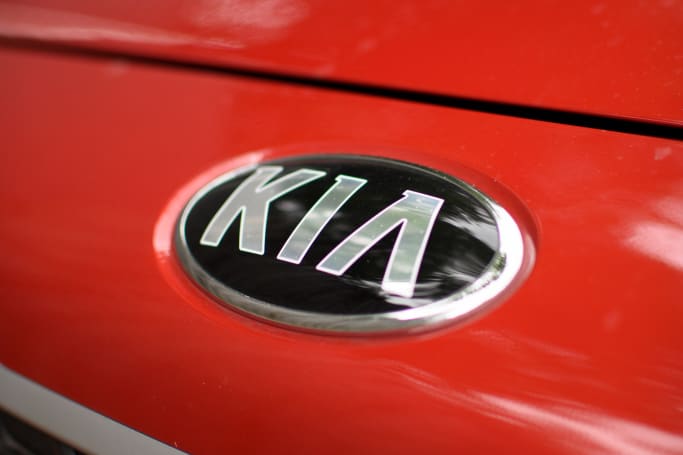
There is also a capped-price-servicing program offered for the lifetime of the warranty costing between $248 and $600 per visit, averaging out to $390.71 per 15,000km interval.
The Rio S is a good-looking and well-sized small hatch which could easily appeal to penny-pinching buyers with its impressive warranty, fantastic multimedia offerings and its solid practicality.
It’s let down by an ancient engine and transmission combination that belongs in the past, and it would make a better proposition if it was at least $1000 cheaper or came with the Rio Sport’s six-speed auto.
| Vehicle | Specs | Price* | |
|---|---|---|---|
| S | 1.4L, ULP, 4 SP AUTO | $12,320 – 16,390 | 2019 Kia Rio 2019 S Pricing and Specs |
| Sport | 1.4L, ULP, 6 SP MAN | $11,110 – 15,290 | 2019 Kia Rio 2019 Sport Pricing and Specs |
| GT-Line | 1.0L, ULP, 7 SP AUTO | $16,280 – 20,900 | 2019 Kia Rio 2019 GT-Line Pricing and Specs |
| Price and features | 7 |
|---|---|
| Design | 8 |
| Practicality | 7 |
| Under the bonnet | 5 |
| Efficiency | 6 |
| Driving | 6 |
| Safety | 7 |
| Ownership | 9 |
$14,990
Lowest price, based on 120 car listings in the last 6 months